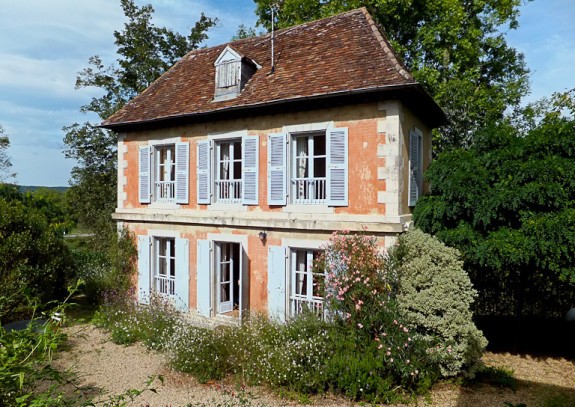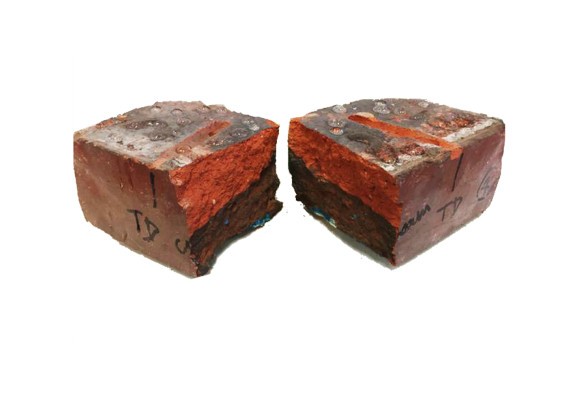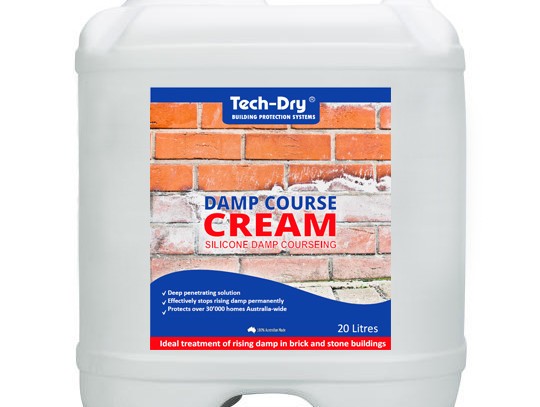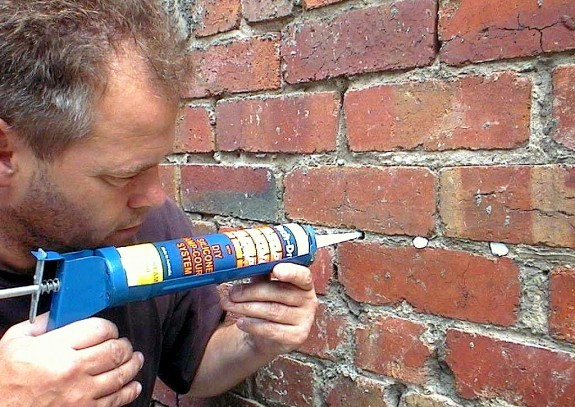- Home
- Products
- Rising Damp Treatment: Fixing Rising Damp
- Damp Course Cream
Damp Course Cream
Description
DAMPCOURSE CREAM is a water-based, environmentally friendly, non-drip thixotropic silane/siloxane formulation designed for use as a damp-proof course in masonry walls. Free from organic solvents, this cream provides a clean, easy-to-apply treatment to permanently stop rising damp in masonry walls.
Recommended Uses
DAMPCOURSE CREAM is designed for injection into the mortar bed of masonry walls. Once installed, the thixotropic cream remains in close contact with the mortar and gradually releases silane/siloxane into its capillaries until fully absorbed. During this process, the cream also penetrates the surrounding bricks or masonry above and below the mortar bed. The silane/siloxane then reacts with the mortar and masonry to form a permanent polysiloxane damp-course within the treated wall.
Installation is simple and cost-effective, requiring no specialised equipment. DAMPCOURSE CREAM suits single, double, or triple brick walls, as well as thick masonry substrates such as block or stone walls with mortar beds. It can be installed from one or both sides of the wall.
After installation, the cream takes several days to fully absorb into the mortar bed. Once absorbed, the mortar becomes water repellent immediately, although full effectiveness may take up to seven days or longer depending on site conditions.
Features
- Environmentally friendly water-based formulation
- Zero VOC
- Equal or better performance than pressure damp course injection
- Quick Quick and easy DIY damp proof course application
- Odourless solution and minimal staining
- Effective in a wide range of substrates
Use Instructions
Installing DAMPCOURSE CREAM requires a hammer drill, a 10 or 12 mm masonry drill bit, a 23 cm caulking gun, and a vacuum cleaner. To ensure correct installation, follow the instructions outlined below:
- It is important that a pilot trial is performed within the masonry wall before application in order to examine the performance and suitability of DAMPCOURSE CREAM for the purpose.
- Locate a mortar joint at a position normally 150mm above ground level, or at or just above floor level so both sides of the wall are evident. If installation is undertaken from the inside, carefully remove any skirting boards present to reveal the lowest mortar course above the floor.
- Mark holes at approximately 80 mm apart so that 3 holes can be drilled horizontally into the mortar bed of each length of brick of approximately 230 mm. The drilling depth should be approximately 10 mm less than the wall thickness. Avoid drilling holes directly above the vertical mortar joint as shown in Figure 1.
- Completely remove the dust from the holes using a vacuum cleaner fitted with a proper adapter that can suck the dust from inside of the holes. It is important that NO drill dust is left in the holes!
Figure 1. Positions for drilling
- Inject DAMPCOURSE CREAM slowly into each hole using a standard caulking gun. Extend the nozzle of the gun to the rear of the hole and slowly withdraw the nozzle as the cream is filling the hole. Make sure holes are filled fully with the cream and avoid any bubbles and hollows when filling.
- Each hole should be filled with approximately 12ml of the cream for a single brick wall. Therefore, the consumption of DAMPCOURSE CREAM should be approximately 150ml per metre of single brick wall or 300ml per metre of double brick wall per filling.
- The cream in the holes may take up to 24 hrs or more to be fully absorbed by the mortar bed and the bricks. After the cream is absorbed, there should be a continuous horizontal absorption mark (wet mark) in the treated mortar bed and/or the bricks above and below the treated mortar bed. After the cream is completely absorbed, the water repellency may also be tested by drilling several small holes in the middle of two holes within the treated mortar bed after 7 days. If the cream penetration (or water repellency from the test) has not reached the mortar in the middle of two holes, a second or more fills with DAMPCOURSE CREAM may be required.
- Initial water repellency should be developed immediately after the cream is absorbed. However, the full strength of the water repellency within the treated mortar bed may take up to seven days or more after the cream is absorbed.
- The new damp course will permanently stop the rising damp. The water which is already present in the wall above the damp course will start to evaporate out as soon as the damp course is installed. In general, the treated masonry wall should be then allowed to dry for up to 6 months before rendering, plastering and/or painting is carried out. Please refer to information for treatment of wall following damp-course installation.
Typical Data
- Appearance: White thixotropic cream
- Active ingredients: >80%
- Specific gravity: approx. 0.90 g/cm3
- pH value: 7-8
- Solubility in water: Miscible
- VOC content: Nil
- Flash point: >61oC
Important Note
As masonry materials and the condition of buildings vary, it is always recommended that a pilot trial should be carried out prior to installation of DAMPCOURSE CREAM to determine the suitability of this product for the purpose.
Handling & Storage
DAMPCOURSE CREAM is classified as a non-hazardous material according to the criteria of Worksafe Australia. However, as with all chemical products, good industrial hygiene procedures should be followed when using this product. The product should be stored in closed containers in a cool dry place away from any fire sources. The product has a shelf life of 6 months in a sealed container stored between 0oC to 25oC.
Packaging
DAMPCOURSE CREAM is available in a 300ml caulking tube or in 5 and 20 litre plastic pails. Other size containers may be available on request.
APPLICATION AMENDMENT: Tech-Dry Damp Course Cream
Recommended dosage 1 x 300ml tube will treat 1 lineal metre of single brick (110mm). This includes 2 applications.
Have a look how the Damp Course Cream is installed with our step-by-step video:
For more information on how to install the DPC Cream via 300ml, click here.
Not sure if you should go for the Damp Course Cream or the Damp Course Fluid?
Check out our fact check and make an informed decision, here.







